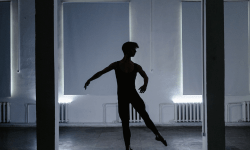Dear Doc:
Having just watched “Dancing With the Stars,” and feeling a bit down over Barry Williams’ loss (but happy that Jason Mraz made it to the finals), I got to wondering if dances can be protected by a copyright registration so that they can’t be copied. May just anyone “moonwalk,” or did Michael Jackson register that move? Inquiring hoofers want to know!
Signed,
Alfonzo and Julianne (no, not them!)
Dear A&J:
The 1976 Copyright Act (17 U.S.C. §101) expanded protection for dance by adding “choreographic works” as eligible for copyright protection. (Before the 1976 Act, “narrative” dance could be protected as a dramatic work, but “abstract” dance could not. Narrative is the kind one sees in classical ballet and often on the Broadway stage, while abstract is what you’d find on the dance floor at a bar mitzvah.) However, when Congress wrote the law, it did not explicitly say what constituted a choreographic work! Is it Jazz Hands? The Lindy Hop? Sadly, we do not have Len Goodman around to ask anymore!
In a recent case, Hanagami v. Epic Games, the U.S. Court of Appeals for the Ninth Circuit has adopted the definition of “choreography” set forth in the Compendium of U.S. Copyright Office Practices: “the composition and arrangement of a related series of dance movements and patterns organized into a coherent whole.” The Court also provided guidelines for lower courts to use when assessing a claim of dance copyright infringement. In that case, Choreographer Kyle Hanagami sued Epic Games, Inc., the creator and developer of the Fortnite video game, for copyright infringement, claiming that Epic Games copied one of Hanagami’s choreographic works. In 2017, Hanagami created and published on his YouTube channel a video depicting a five-minute dance performance (the “Hanagami Choreography”). Hanagami subsequently obtained a copyright registration for his choreographic sequence. In 2020, Epic Games released a new chapter of its Fortnite video game and included virtual animations that players could purchase for their avatars to perform. (The Doc has no idea why one would purchase such a thing, but then, the Doc is old enough to remember when people danced the “mashed potato” and the “frug.”) Hanagami alleged that one of these animations contained a segment of the Hanagami Choreography, and that this particular segment was the most recognizable and distinctive portion of his work.
Epic Games moved to dismiss Hanagami’s claim on the basis that (1) the allegedly copied dance steps were not protectable and (2) the works were not substantially similar. The trial court granted the motion, holding that the steps Epic Games purportedly copied were just a number of individual poses that were unprotectable when viewed in isolation. The court also found that Hanagami was entitled to protection only for the way the dance steps were expressed in the work as a whole, and the collection of purportedly copied steps constituted only a small part of his full work. Based on this scope of protection, the district court compared the Hanagami Choreography to the Epic Games animation and determined that the works were not “substantially similar”.
The Ninth Circuit Court of Appeals reversed the trial court’s ruling, saying that the trial court did not properly break down the elements of the choreographic work. They agreed with Hanagami’s argument that individually unprotectable “poses” are not the only relevant element underlying a choreographic work, and the relationship between movements and patterns and the choreographer’s creative approach to composing and arranging them together is what defines the work. The court said that other forms of copyrightable material are also composed of individual elements that are unprotectable when viewed in isolation (such as words or shapes), but that the particular combination of these “building blocks” may be eligible for copyright protection (see, Robert Rauschenberg, “White Painting” [three panel], 1951). The Court held that a choreographer’s original selection, coordination, and arrangement of various dance movements is protectable. It went on to say that the job of the lower court is to compare the selection and arrangement of elements in the plaintiff’s choreographic work with that in the allegedly infringing work to determine whether the two works are substantially similar.
The court went on to do that comparison. A side-by-side video prepared by Hanagami’s counsel showing the allegedly copied counts from Hanagami’s choreography next to corresponding clips of the Epic Game animation was referenced by the court and can be found at: https://www.youtube.com/watch?v=vXYDr9o_FJY. The case now goes back to the trial court where, one may imagine, a dance-off will settle the whole kerfuffle. Perhaps a panel comprising Carrie Ann Inaba, Bruno Tonioli, and Derek Hough will be tapped to serve as the court-appointed experts? One can only hope!
Oh. And if you’re wondering, Michael Jackson not only never registered a copyright on the Moonwalk, he didn’t even invent it, as it was a tap dance move called the “backslide.” MJ did perfect it and popularize it, however. He was also a patented inventor of a special shoe that allowed him to give the illusion of leaning far beyond his center of gravity, which he used in the video for “Smooth Criminal.” So, if you’ve got the moves, the attorneys at LW&H are here to help protect them, and the rest of your intellectual property. Quickstep on over, and they’ll show you some legal fancy footwork.
Until next month,
The “Doc”
— Lawrence A. Husick, Esq.



